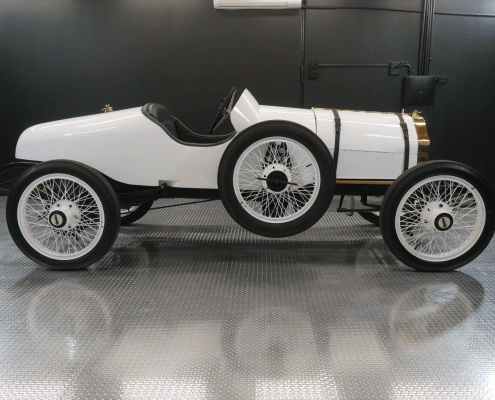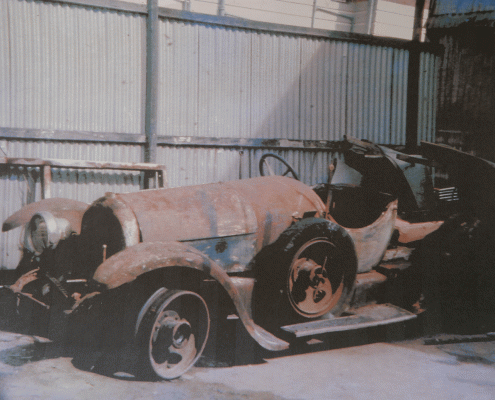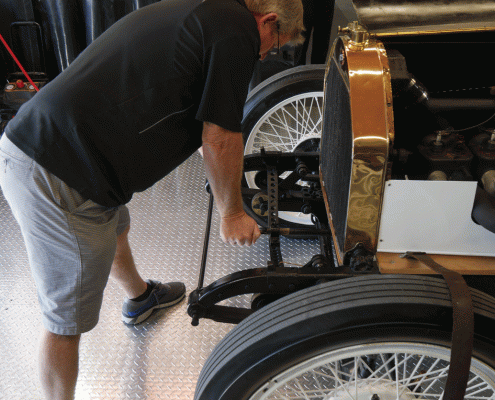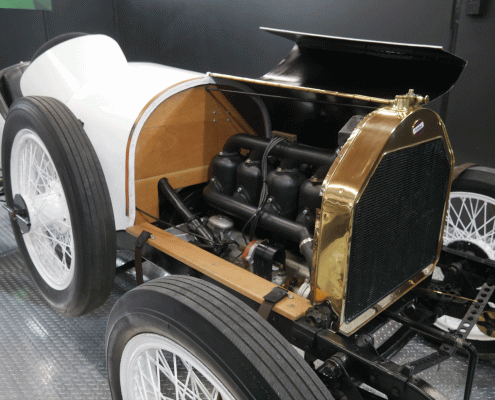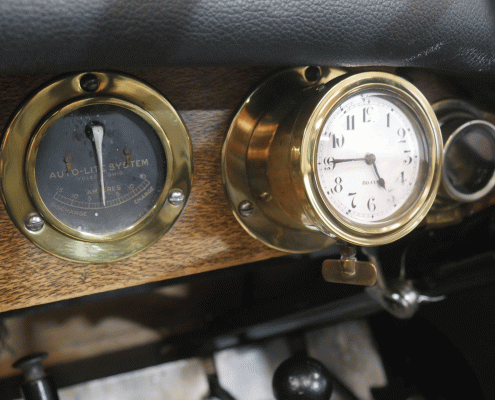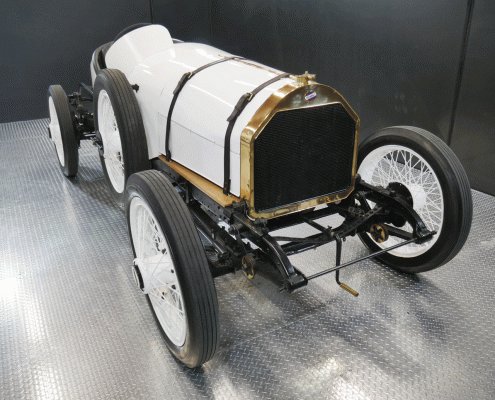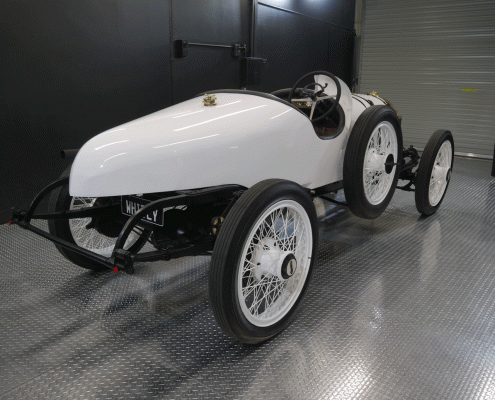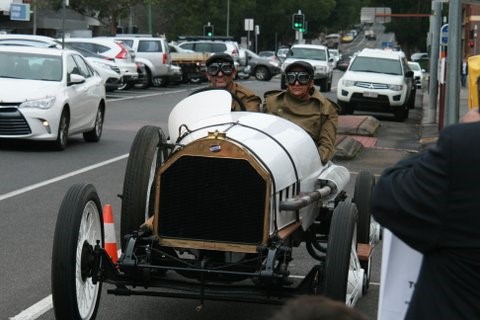1912 Willys-Overland, Model 61
Owner: Graham Crittenden
Published: September 2018
You may not recognise the name, but 100 years ago, Willys-Overland was one of the world’s largest car manufacturers.
Founded in 1912 after John Willys – a successful car dealer – had bought the struggling Overland car company in 1908, Willys-Overland would, for a brief period before and after WWI, be the second largest manufacturer in the U.S. after Ford.
Perhaps best known for its ubiquitous Willys MB, or Jeep (of which more than 600,000 saw service during WWII) Willys-Overland had a long and storied history before disappearing into the labyrinth of corporate takeovers and mergers that saw many a famous automotive name vanish from the books by the second half of the 20th century.
However, being a successful manufacturer of cars did mean there were plenty of early Willys-Overland models about, and thanks to the dedication of the hardy group of souls who collect and restore such veteran automobiles, plenty of the company’s brilliant early cars still survive.
This particular car is a 1912 Model 61, built at the Willys-Overland Indianapolis factory. Known as ‘Whitey’, today the car is owned by Graham Crittenden of Kingaroy – a coach and motor trimmer by trade and a man with a passion for the veteran vehicles that once charged around the rugged ‘tracks’ of Australia, paving the way for the motor industry to take hold across the country.
And Whitey holds a particularly special place in that pioneering history, especially in Queensland, as it played a special role in the early development of what would become one of Australia’s most successful motoring groups – A.P.Eagers.
The story, says Graham, goes back to the company’s earliest days and to its founders, Edward Eager and his son Fred, who owned Whitey and used it in for some years as a promotional tool for the company.
“The Eagers were very entrepreneurial Americans who had come to Brisbane and were actually selling Overlands before they formed their company,” says Graham.
“And they knew the value of publicity. While Fred’s father was the driving force of the business, Fred was able to do the promotional work and he would do things like organise company cars to take orphans to picnics and organise tours to Southport for the weekend – all to keep the company in the public eye.”
But it was Whitey that really made an impact. With speed and record-setting the name of the game in the early days of motoring, Fred Eager drove Whitey to some impressive marks. In 1918, he set record time for the Brisbane to Toowoomba run of 2 hours 7 ½ minutes, and in the same year broke the time for the Sydney to Brisbane route – completing the 621.5 miles in 19 hours 38½ minutes.
There were also records set in hill climbs – Whitey held the Mt Coot-tha climb record from 1916-18 – and in one dramatic event in 1917, a race across the sands of Southport beach on the Gold Coast saw Whitey reach a 4-cylinder speed record of 81mph (130.3 km/h).
It should be remembered, of course, that this was motoring in its infant days. Roads outside of towns were barely tracks and the technology of an automobile was somewhat primitive compared to the air-conditioned luxury we have today. People like Fred Eagers, and his riding-mechanic offsider Wally Webb who accompanied him on many of Whitey’s adventurous drives, really were true motoring pioneers.
And to emphasise that point, it is worth noting that Whitey is a one-of-a-kind car. Though a Model 61 in name, there have been some unique modifications made – most compelled upon its operators by the circumstances of its cross-country exploits.
Graham heard the stories of these alterations straight from Wally Webb, who he was able to meet in the early late 1960s as he researched Whitey’s history.
“I was very fortunate when I bought the car in 1966 that Wally Webb was still alive,” says Graham. “I was able to go to Brisbane and spend the afternoon with him and talk about all the things I had discovered about the car and have them confirmed or corrected. Apart from Fred Eager, who had long since passed away, he was the only other person who was actually there for these events. Wally was a brilliant engineer and was the only person to work on the car really – it was his job to make it perform at its best.
“He told me that the big problem with inter-city racing was the little wash-outs that ran across the dirt roads,” he adds. “The water would wash across the gravel road and make a little gully and drivers would call these things ‘spring breakers’ because they could cause the chassis to snap in the middle. When that happened, he said you could hear a noise like a gunshot when a car went through a gully as the metal at the break flicked past one another.
“What Wally did to prevent this happening to Whitey was to unrivet the whole chassis, cut a piece of plate steel ⅜-of-an-inch thick and put it inside the C-section. He then re-riveted the chassis back again. They never had any problems following that reinforcement and that work is still visible today.
“Wally also fitted two shock absorbers on each corner – so Whitey has 8 shocks – and that helped with stability in the axles when on dubious roads.”
Another element of Whitey that, not surprisingly, gave Fred and Wally some grief during distance races on less than perfect roads, was the wheels, which they had already changed to wire models from the original wooden-spoked variety.
“Wally did tell me that on the route to Sydney, they actually lost a wheel, and ‘had a devil of a time finding it because it had just gone off into the bush!’,” says Graham with a laugh. “They did eventually find the wheel and, when they got to Sydney, Wally made some modifications to the hubs. There were originally six driving pins, but Whitey now has only three because Wally cut three pins off and fitted studs and nuts onto the hubs so he could secure the wheels and lock them on. That too, is still a feature of the car.”
Graham has a million more stories of Whitey’s adventures – including that of a hastily-fashioned muffler made from an old oil can, a piece of flat metal and some wire ripped from a roadside fence, that was then used to replace one that had blown to bits during a run – but they all beg the question of how such an important car, that played such an interesting role in Queensland’s early motoring history, found its way into his possession?
At some point following the flurry of promotional success, it can be assumed that Whitey was put out to pasture as more modern Overland models became available. Exactly what happened is a bit of a mystery but in 1963 the car was discovered, in a rather sad state of disrepair, in the back of a Brisbane workshop.
“The Guthrie family, who at the time were panel beaters in the Valley, actually found Whitey by accident,” says Graham. “They were doing a towing job down in Ferny Grove when they got a flat tyre and needed to get it fixed. They found an open workshop, but no one was around, so they walked around the back of the garage and there was the car!
“It wasn’t in great shape, but they did as good a restoration job on it as they could considering they didn’t have access to the information we have now. They couldn’t find wire-spoked wheels to put back on it, and they did have to do some more modifications to tyres that would fit – tyres were a big problem for restorers back then. They also had to build the back body of the car, which they knew would be pointed, but built it about 18 inches shorter than the original.
“Given what they had to work with, they did a great job in resurrecting the car and I bought it from them in 1966.”
Over the next few years, Graham would bring Whitey back to something like its Wally Webb-engineered uniqueness, but not until it too had put him through some grief.
“It was driveable when I got it, so I decided to take it from Kingaroy to Maryborough for a rally, but on the way, I ran a big end,” he says. “As you did in the days when you were young and agile, I got stuck in and by the end of the day had pulled the sump off, pulled the connecting rod out and together with an engineer friend in Maryborough, had white-metalled the bearing, scraped it and put it back together so that by midnight the car was running again.
“On the way back to Kingaroy, however, I ran another big end and I realised there was something really wrong. I found out that the engine had three steel racing pistons and one cast iron piston, with the cast iron piston being about twice the weight of the others. At some point, one of the steel pistons must have broken and been replaced with the cast iron one.
“I set about getting an aluminium piston and shaved away as much of it as I could to get down to the weight of these three racing pistons, but in 1968, on the 50th anniversary of the Brisbane to Toowoomba run, we ran a big end again! Ultimately, I had the engine completely rebuilt and a whole new set of aluminium pistons put in, and we haven’t had any trouble since.
“Over time we also got some good photographs of the car in its heyday and were able to rebuild the back of the body to its proper size. Now it looks like it did when Fred Eager and Wally Webb were racing it.”
Graham’s passion for veteran cars got its start when he was a kid. His father was a car dealer in Kingaroy and the young Graham soon became enamoured with the vehicles that came through the shop. A career working with cars was always on the cards.
“Because my father was in the car business, I grew up with cars,” he says. “As a dealer, he thought of cars as a means of earning a living, but I had a different view of them and grew to appreciate all the different types of cars and models I saw – and I did have access to a lot of them.
“He was an Austin dealer and I remember when the Austin Atlantic came to Australia in 1949. I had the day off school so that I could go down to Brisbane and collect the first one and drive it back with him. I remember that day as if it was yesterday. It meant so much to me – the Atlantic was a revolutionary-looking car.
“Eventually, I became an apprentice coach and motor trimmer and I still work at my trade to this day, and I am 78!”
While Graham’s business has evolved over the decades to include other sectors in which his skills are required – including furniture upholstery, canvas work and vinyls – working on the restoration of veteran cars, be it his own or those others, has been a constant, and he says he can often spot his own handiwork on other classic vehicles.
Whitey, of course, is in its current condition because of his efforts. But it is not alone. Over the decades Graham, who has been a member of the Veteran Car Owners Club for more than 60 years, has owned many veteran vehicles and he still does have a substantial collection. Amongst them are German-made Stoewers, a 1916 Buick and a 1916 Dodge. He has also owned a couple of Model T Fords and recently passed on to his daughter Sally a complete 1914 Overland that he had owned and stored away for more than 50 years.
After a lifetime restoring and enjoying veteran cars, the time might have come, says Graham, that collecting them has come to an end. In fact, he says, he may start reducing his collection.
Whitey, however, will likely remain part of his life, as will his involvement with the veteran car club-owning community.
“Whitey is probably worth quite a bit, but it is the historic value of this car that is important, and you can’t just go out and buy that sort of history,” he says.
“I have loved being involved with veteran cars. It doesn’t matter if you’re a doctor or a ditch digger, you have a level playing field when you talk about old cars. It is the most wonderful hobby and I have met wonderful people from all over the world because of it.”




